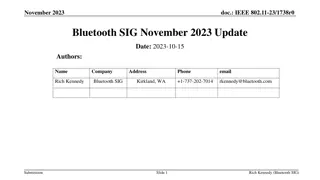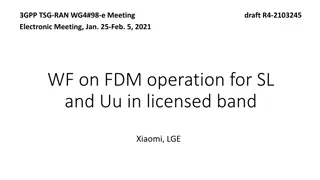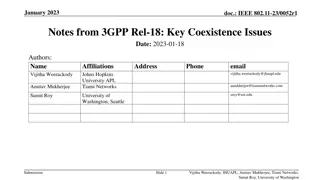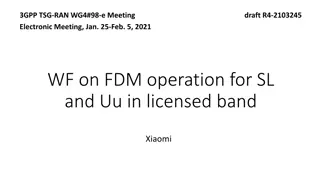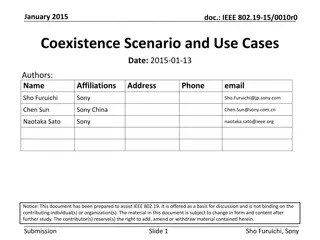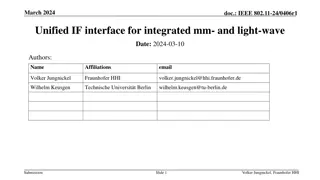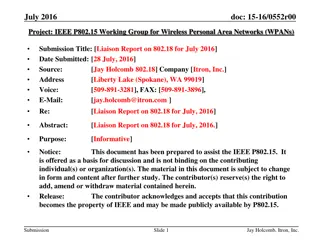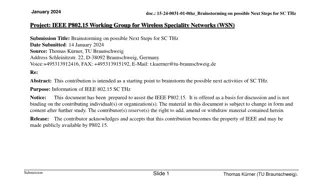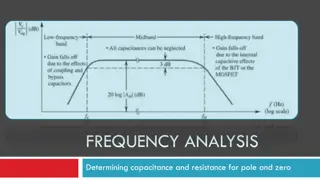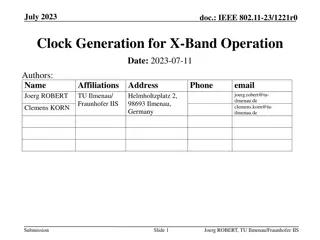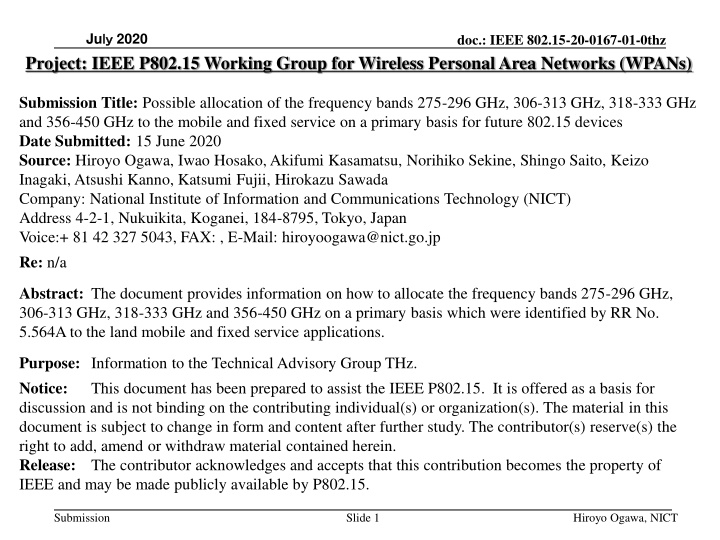
Possible Allocation of Frequency Bands for Future Wireless Devices
Explore the proposal to allocate frequency bands in the range of 275-450 GHz for mobile and fixed services, aiming to support advanced technologies like TG3d devices. The document discusses the need for contiguous bandwidth, constraints, and the global commercialization perspective from a spectrum point of view.
Download Presentation

Please find below an Image/Link to download the presentation.
The content on the website is provided AS IS for your information and personal use only. It may not be sold, licensed, or shared on other websites without obtaining consent from the author. If you encounter any issues during the download, it is possible that the publisher has removed the file from their server.
You are allowed to download the files provided on this website for personal or commercial use, subject to the condition that they are used lawfully. All files are the property of their respective owners.
The content on the website is provided AS IS for your information and personal use only. It may not be sold, licensed, or shared on other websites without obtaining consent from the author.
E N D
Presentation Transcript
Ju 2020 doc.: IEEE 802.15-20-0167-01-0thz Project: IEEE P802.15 Working Group for Wireless Personal Area Networks (WPANs) Submission Title: Possible allocation of the frequency bands 275-296 GHz, 306-313 GHz, 318-333 GHz and 356-450 GHz to the mobile and fixed service on a primary basis for future 802.15 devices Date Submitted: 15 June 2020 Source: Hiroyo Ogawa, Iwao Hosako, Akifumi Kasamatsu, Norihiko Sekine, Shingo Saito, Keizo Inagaki, Atsushi Kanno, Katsumi Fujii, Hirokazu Sawada Company: National Institute of Information and Communications Technology (NICT) Address 4-2-1, Nukuikita, Koganei, 184-8795, Tokyo, Japan Voice:+ 81 42 327 5043, FAX: , E-Mail: hiroyoogawa@nict.go.jp Re: n/a Abstract: The document provides information on how to allocate the frequency bands 275-296 GHz, 306-313 GHz, 318-333 GHz and 356-450 GHz on a primary basis which were identified by RR No. 5.564A to the land mobile and fixed service applications. Purpose: Information to the Technical Advisory Group THz. Notice: This document has been prepared to assist the IEEE P802.15. It is offered as a basis for discussion and is not binding on the contributing individual(s) or organization(s). The material in this document is subject to change in form and content after further study. The contributor(s) reserve(s) the right to add, amend or withdraw material contained herein. Release: The contributor acknowledges and accepts that this contribution becomes the property of IEEE and may be made publicly available by P802.15. Submission Slide 1 Hiroyo Ogawa, NICT
Ju 2020 doc.: IEEE 802.15-20-0167-01-0thz Background The document [1][2] proposed to use the additional frequency band 252-275 GHz which are already allocated to the mobile service for TG3d devices so that the contiguous bandwidth over 40 GHz can be achieved. The basic channel bandwidth for TG3d devices is 2.160 GHz. Four bonded channel bonding is applied to create the second basic channel whose channel bandwidth is 8.640 GHz, as shown below [1]. To accommodate such broadband channels, the contiguous bandwidth over 20 GHz is required for TG3d device operation. CH1 CH2 CH3 CH4 2.160GHz 2.160GHz 2.160GHz 2.160GHz 8.640GHz 8.640GHz 8.640GHz 8.640GHz 8.640GHz BW=43.2GHz 252GHz 295.2GHz The frequency bands 275-296 GHz, 306-313 GHz, 318-333 GHz and 356-450 GHz are identified for use by administrations for the implementation of land mobile and fixed service applications, in accordance with RR No. 5.564A [3][4]. Submission Slide 2 Hiroyo Ogawa, NICT
Ju 2020 doc.: IEEE 802.15-20-0167-01-0thz Global Commercialization of TG3d Device from Spectrum Point of View The first contiguous bandwidth of 44 GHz is achieved as follows: Already allocated in RR New identified frequency band 252 GHz * The frequency of 320 GHz was originally proposed by Ref.[2], but the frequency bands 296-306 GHz and 313-318 GHz were not identified for mobile service applications in accordance with RR No. 5.564A. 275 GHz 296 GHz* The second contiguous bandwidth of 94 GHz is achieved as follows: New identified frequency band 356 GHz 450 GHz The following constraint is included in RR No.5.564A because the frequency bands are identified, but not allocated in the Table of Frequency Allocations. The use of the above-mentioned frequency bands by land mobile and fixed service applications does not preclude use by, and does not establish priority over, any other applications of radio services in the range of 275-450 GHz. WRC-27 agenda item which allocates the frequency bands for mobile and fixed services on a primary basis is preferable to globally or regionally commercialize TG3d devices and other applications such as 6G (5G Beyond). Slide 3 Hiroyo Ogawa, NICT Submission
Ju 2020 doc.: IEEE 802.15-20-0167-01-0thz Possible Table of Frequency Allocations 275-296 GHz New Table of Frequency Allocations in the frequency band 275-296 GHz to the mobile and fixed services including Earth exploration-satellite service and radio astronomy service as primary basis. Allocation to services 275-286 GHz EARTH EXPLORATION-SATELLITE (passive) FIXED MOBILE RADIO ASTRONOMY 286-296 GHz FIXED MOBILE RADIO ASTRONOMY Hiroyo Ogawa, NICT Submission Slide 4
Ju 2020 doc.: IEEE 802.15-20-0167-01-0thz Possible Table of Frequency Allocations 306-313 GHz New Table of Frequency Allocations in the frequency band 306-313 GHz to the mobile and fixed services including Earth exploration-satellite service and radio astronomy service as primary basis. Allocation to services 306-313 GHz FIXED MOBILE RADIO ASTRONOMY Hiroyo Ogawa, NICT Submission Slide 5
Ju 2020 doc.: IEEE 802.15-20-0167-01-0thz Possible Table of Frequency Allocations 318-333 GHz New Table of Frequency Allocations in the frequency band 318-333 GHz to the mobile and fixed services including Earth exploration-satellite service and radio astronomy service as primary basis. Allocation to services 318-323 GHz EARTH EXPLORATION-SATELLITE (passive) FIXED MOBILE RADIO ASTRONOMY 323-327 GHz EARTH EXPLORATION-SATELLITE (passive) FIXED MOBILE 327-333 GHz EARTH EXPLORATION-SATELLITE (passive) FIXED MOBILE RADIO ASTRONOMY Hiroyo Ogawa, NICT Submission Slide 6
Ju 2020 doc.: IEEE 802.15-20-0167-01-0thz Possible Table of Frequency Allocations 356-450 GHz (1) New Table of Frequency Allocations of the frequency band 356-450 GHz to the mobile and fixed services including Earth exploration-satellite service and radio astronomy service as primary basis. Allocation to services 356-361 GHz FIXED MOBILE RADIO ASTRONOMY 361-365 GHz EARTH EXPLORATION-SATELLITE (passive) FIXED MOBILE RADIO ASTRONOMY Hiroyo Ogawa, NICT Submission Slide 7
Ju 2020 doc.: IEEE 802.15-20-0167-01-0thz Possible Table of Frequency Allocations 356-450 GHz (2) Allocation to services 365-369 GHz FIXED MOBILE RADIO ASTRONOMY 369-371 GHz EARTH EXPLORATION-SATELLITE (passive) FIXED MOBILE RADIO ASTRONOMY 371-388 GHz EARTH EXPLORATION-SATELLITE (passive) FIXED MOBILE 388-392 GHz EARTH EXPLORATION-SATELLITE (passive) FIXED MOBILE RADIO ASTRONOMY 392-397 GHz FIXED MOBILE RADIO ASTRONOMY Hiroyo Ogawa, NICT Submission Slide 8
Ju 2020 doc.: IEEE 802.15-20-0167-01-0thz Possible Table of Frequency Allocations 356-450 GHz (3) Allocation to services 397-399 GHz EARTH EXPLORATION-SATELLITE (passive) FIXED MOBILE RADIO ASTRONOMY 399-409 GHz FIXED MOBILE RADIO ASTRONOMY 409-411 GHz EARTH EXPLORATION-SATELLITE (passive) FIXED MOBILE RADIO ASTRONOMY 411-416 GHz FIXED MOBILE RADIO ASTRONOMY 416-424 GHz EARTH EXPLORATION-SATELLITE (passive) FIXED MOBILE RADIO ASTRONOMY Hiroyo Ogawa, NICT Submission Slide 9
Ju 2020 doc.: IEEE 802.15-20-0167-01-0thz Possible Table of Frequency Allocations 356-450 GHz (4) Allocation to services 424-426 GHz EARTH EXPLORATION-SATELLITE (passive) FIXED MOBILE 426-434 GHz EARTH EXPLORATION-SATELLITE (passive) FIXED MOBILE RADIO ASTRONOMY 434-439 GHz FIXED MOBILE RADIO ASTRONOMY 439-442 GHz EARTH EXPLORATION-SATELLITE (passive) FIXED MOBILE RADIO ASTRONOMY 442-450 GHz EARTH EXPLORATION-SATELLITE (passive) FIXED MOBILE Hiroyo Ogawa, NICT Submission Slide 10
Ju 2020 doc.: IEEE 802.15-20-0167-01-0thz Conclusion The Table of Frequency Allocations proposed in this contribution is one example and not yet discussed in any regulatory organizations, however this information may be useful for IEEE802.15 TAG THZ to identify the future regulatory and standardization activities to globally commercialize TG3d devices. IEEE802 should provide ITU-R more detailed technical and operational characteristics of mobile and fixed service applications operating in the frequency bands 275-296 GHz, 306-313 GHz, 318-333 GHz and 356-450 GHz if requested, because IEEE802 provided ITU-R useful technical information for sharing and compatible studies between TG3d devices and EESS passive sensors under WRC- 19 agenda item 1.15. IEEE802.15 TAG THZ should encourage administrations, from the industry point of view, to discuss the possible WRC-27 new agenda item which considers primary allocation of the frequency bands 275-296 GHz, 306-313 GHz, 318-333 GHz and 356-450 GHz to the mobile and fixed services for not only wireless PAN/LAN but also other wireless applications such as 6G (Beyond 5G). Submission Slide 11 Hiroyo Ogawa, NICT
Ju 2020 doc.: IEEE 802.15-20-0167-01-0thz References [1] 15-15-0038-00-003d-proposed-frequency-arrangements-to- section-10-of-tg3d-trd. [2] 15-15-0052-01-003d-operational-frequency-band-for-tg3d- devices. [3] 15-20-0149-01-0thz-results-of-wrc-2019-ai-1-15-and-its- impact-on-thz-communications. [4] World radiocommunication Conference 2019 (WRC-19) Final Acts. https://www.itu.int/pub/R-ACT-WRC.14-2019 Submission Slide 12 Hiroyo Ogawa, NICT

